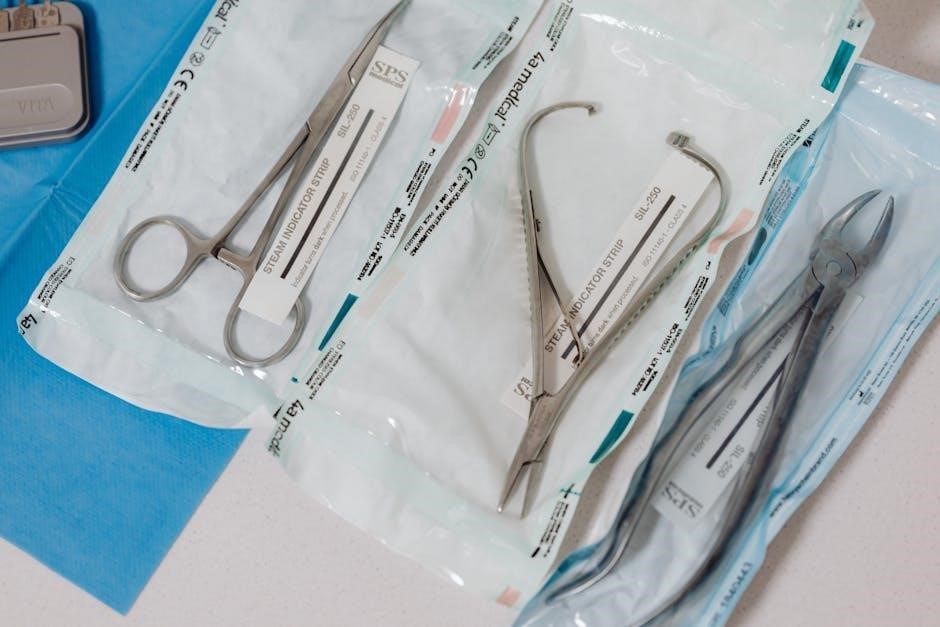Dental terminology PDF guides provide comprehensive resources for understanding dental science, covering tooth surfaces, anatomical structures, and procedural terms essential for effective communication in dentistry.
1.1 Definition and Scope
Dental terminology is the standardized language used to describe dental procedures, anatomical structures, and conditions. It combines Greek, Latin, and modern terms, forming the foundation of dental communication. The scope includes definitions for tooth surfaces, oral anatomy, diagnostic terms, and treatment procedures, ensuring precise understanding among professionals. This terminology is essential for accurate documentation, effective patient care, and clear communication in dentistry.
1.2 Importance in Dentistry
Dental terminology is vital for precise communication among professionals, ensuring accurate documentation and effective patient care. It standardizes language, reducing misunderstandings and enhancing clarity in diagnoses, treatments, and records. This consistency is crucial for legal compliance, insurance claims, and interdisciplinary collaboration, ultimately improving patient outcomes and streamlining dental practice operations.

The Structure of Dental Terminology
Dental terminology is built using Greek and Latin roots, prefixes, and suffixes, forming precise terms essential for clear communication in dentistry, as seen in tooth surfaces and anatomical structures.
2.1 Roots, Prefixes, and Suffixes
Dental terminology relies on Greek and Latin roots, prefixes, and suffixes to form precise terms. For example, “occlusal” combines “occlus” (to close) with “-al,” indicating relation to the biting surface. “Incisal” derives from “incis” (to cut) and “-al.” Terms like “prophylaxis” (prevention) and “crown” (tooth restoration) illustrate this. Understanding these components enhances clear and effective communication in dental practice and education.
2.2 Common Word Components
Common word components in dental terminology include specific terms for tooth surfaces, procedures, and conditions. Terms like “buccal” (towards the cheek) and “lingual” (towards the tongue) describe tooth surfaces. “Occlusal” refers to the biting surface, while “incisal” denotes the cutting edge. Procedural terms like “prophylaxis” (cleaning) and “restoration” (filling) are also widely used. These components are essential for clear communication in dental practice and documentation.

Key Dental Terms
Dental terminology includes basic, anatomical, procedural, and diagnostic terms essential for accurate communication. These terms describe tooth structures, treatments, and conditions, forming the foundation of dental practice.
3.1 Basic Terms
Dental terminology begins with basic terms that describe fundamental concepts. These include words like crown (visible part of the tooth), root (hidden portion), enamel (hard outer layer), and dentin (inner tissue). Understanding these terms is crucial for effective communication in dentistry, as they form the foundation for more complex terminology. Basic terms also include pulp (soft tissue inside the tooth) and gingiva (gums), essential for describing oral structures and conditions.
3.2 Anatomical Terms
Anatomical terms in dentistry describe the structures of the mouth and teeth. Key terms include maxilla (upper jaw) and mandible (lower jaw), which house the teeth. Surfaces like buccal (cheek side), lingual (tongue side), and palatal (palate side) are essential for identifying tooth locations. These terms are vital for accurate clinical documentation and communication among dental professionals, ensuring precise descriptions of anatomical features and their conditions.
3.3 Procedural Terms
Procedural terms describe dental treatments and operations. Common terms include prophylaxis (professional cleaning), crown (tooth restoration), and scaling (plaque removal). These terms are essential for documenting treatments, ensuring clear communication between dental professionals. Understanding procedural terminology aids in accurate record-keeping and effective patient care, making it a cornerstone of dental practice and communication.
3.4 Diagnostic Terms
Diagnostic terms are used to identify and describe oral conditions. Terms like cavity, caries, and periodontal pockets help diagnose issues. Periodic oral evaluation (D0120) and radiographs (X-rays) are key diagnostic tools. These terms enable accurate assessment of oral health, guiding treatment plans and ensuring proper patient care. Understanding diagnostic terminology is crucial for effective communication and precise treatment outcomes in dentistry.
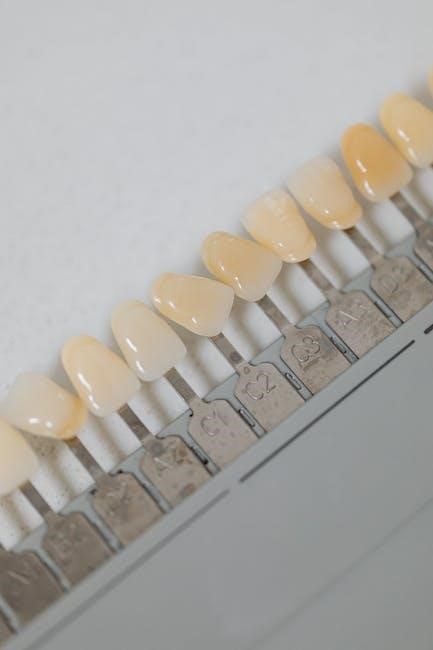
Tooth Surfaces Terminology
Tooth surfaces terminology includes buccal (towards the cheek), lingual (towards the tongue), labial (towards the lips), and palatal (towards the palate) areas, aiding precise dental documentation.
4.1 Buccal, Lingual, Labial, Palatal
Buccal refers to the tooth surface facing the cheek, while lingual faces the tongue. Labial surfaces are near the lips, and palatal surfaces are toward the palate. These terms are essential for accurately describing tooth positions and procedures, ensuring clear communication in dental care and documentation. Understanding these surfaces aids in diagnoses, treatments, and recording patient-specific details effectively.
4.2 Occlusal and Incisal Surfaces
Occlusal surfaces refer to the chewing areas of posterior teeth, while incisal surfaces are the cutting edges of anterior teeth. These terms are crucial for describing tooth anatomy and functional aspects. Understanding occlusal and incisal surfaces aids in diagnosing wear patterns, aligning bites, and planning restorative procedures. Accurate terminology ensures precise communication in dental treatments and documentation.
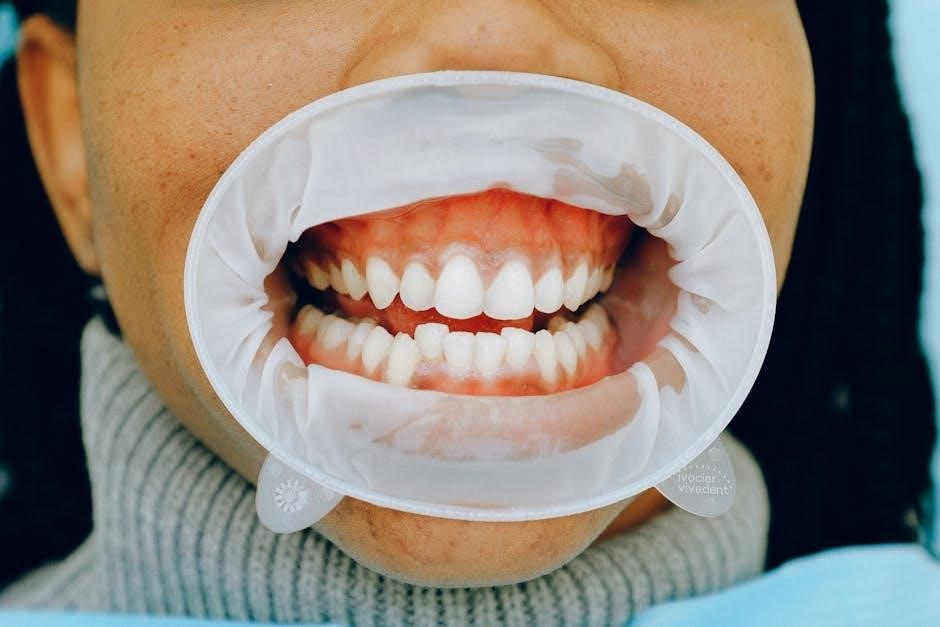
Common Oral Conditions
Common oral conditions include cavities, caries, gingivitis, and periodontitis. These terms are essential for understanding and treating dental issues, ensuring proper diagnosis and effective patient care.
5.1 Cavity and Caries
A cavity, also known as dental caries, is a bacterial infection causing tooth decay. It begins with enamel demineralization, progressing to dentin and potentially pulp damage. Symptoms include pain or sensitivity; Prevention involves fluoride treatments, sealants, and good hygiene. Treatment options range from fillings to root canals, depending on severity. Early detection is crucial to avoid complications and preserve tooth structure.
5.2 Gingivitis and Periodontitis
Gingivitis is inflammation of the gums caused by plaque buildup, leading to redness, swelling, and bleeding. Untreated, it progresses to periodontitis, affecting the tooth-supporting structures. Symptoms include loose teeth, bad breath, and pocket formation.
Prevention involves regular brushing, flossing, and professional cleanings. Treatments range from deep cleaning to surgery, depending on severity. Early intervention is key to halting disease progression and preserving oral health.
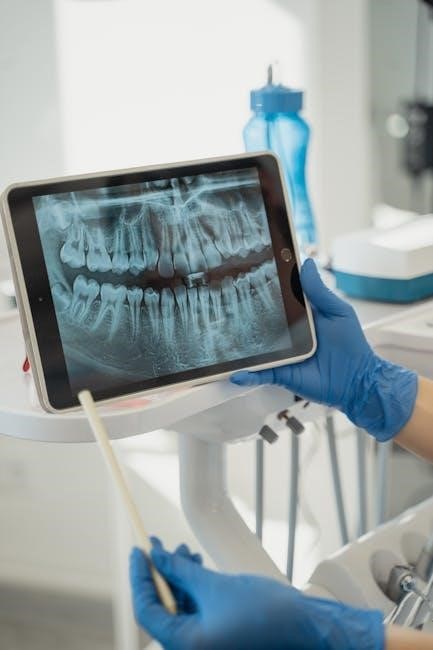
Dental Procedures and Treatments
Dental procedures include preventive care like prophylaxis, restorative treatments such as fillings and crowns, and surgical options like extractions and implants.
6.1 Common Procedures
Common dental procedures include prophylaxis (professional cleaning), fillings, crowns, extractions, and implants. Preventive care like fluoride treatments and sealants is also essential. Restorative procedures address tooth decay, while surgical options like root canals or wisdom tooth removal treat advanced issues. These procedures ensure patient oral health, preventing further complications and improving dental function.
6.2 Terminology Related to Treatments
Dental treatment terminology includes terms like “crown” (a tooth covering) and “abutment” (supporting a dental appliance). Prophylaxis refers to professional cleanings, while “accepted fee” denotes the agreed payment for services. Terms like “restoration” and “extraction” describe specific treatments, ensuring clear communication between professionals and accurate documentation in patient records and billing processes.
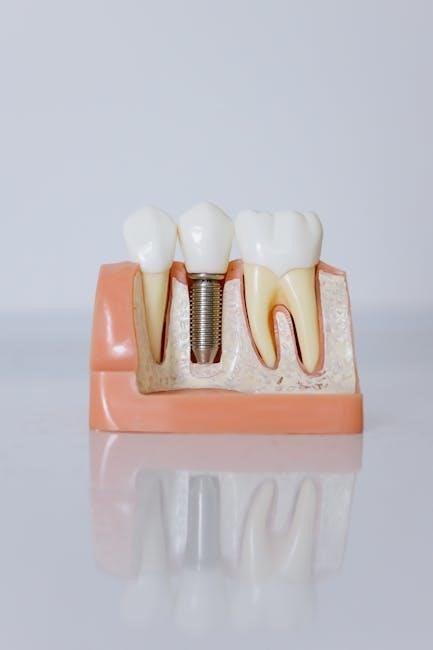
Anatomical Structures
Dental anatomy focuses on the maxillary (upper jaw) and mandibular (lower jaw) regions, including tooth surfaces like buccal, lingual, labial, and palatal. These structures are fundamental for accurate diagnoses and treatments.
7.1 Maxillary and Mandibular
The maxillary refers to the upper jaw, housing the upper teeth, while the mandibular pertains to the lower jaw, which holds the lower teeth. These structures are essential for chewing, speaking, and maintaining facial aesthetics. The maxilla and mandible bones support the dentition, with the maxillary arch typically larger than the mandibular. Understanding these regions is crucial for accurate diagnoses and effective dental treatments.
7.2 Dental Anatomy Basics
Dental anatomy focuses on the structure of teeth and their components. The crown is the visible part, while the root anchors the tooth in the jawbone. Enamel covers the crown, protecting it, and dentin lies beneath. The pulp contains nerves and blood vessels. Teeth surfaces include incisal (biting edge), occlusal (chewing surface), buccal (toward the cheek), lingual (toward the tongue), labial (toward the lips), and palatal (toward the palate). Understanding these basics is fundamental for dental procedures and diagnoses.

Dental Materials and Instruments
Dental materials include amalgam, composite resin, and ceramics for restorations. Instruments like drills, scalers, and mirrors are essential for procedures, ensuring precise and effective patient care and treatment.
8.1 Materials Used
Dental materials include amalgam, composite resin, ceramics, and zirconia, each with specific applications. Amalgam is durable for fillings, while composites mimic natural tooth color. Ceramics are biocompatible and aesthetically pleasing for crowns. Zirconia is prized for its strength in implants. Modern materials like glass ionomer cements and titanium alloys are also used for restorations and surgical implants, ensuring longevity and compatibility with oral tissues.
- Amalgam: Durable for posterior fillings.
- Composite resin: Aesthetic restorations.
- Ceramics: Biocompatible for crowns.
- Zirconia: Strong and durable for implants.
- Glass ionomer cements: Bond to tooth structure.
- Titanium alloys: Used in surgical implants.
Understanding these materials is crucial for effective dental terminology and patient care.
8.2 Instrument Terminology
Dental instruments are essential tools for diagnosing and treating oral conditions. Common instruments include excavators, scalers, and burnishers. Excavators remove decayed tooth material, while scalers clean plaque and tartar. Burnishers smooth surfaces post-procedure. Other key tools like mirrors, probes, and drills aid in examinations and restorations. Understanding instrument terminology is vital for accurate communication among dental professionals and effective patient care.
- Excavators: Remove decayed tooth material.
- Scalers: Clean plaque and tartar.
- Burnishers: Smooth surfaces after procedures.
- Mirrors: Provide visibility in the mouth.
- Probes: Measure pocket depths.
- Drills: Prepare teeth for restorations.
Dental Insurance and Billing Terms
Dental insurance and billing terms involve CDT codes, ADA guidelines, and common terms like “accepted fee” and “periodic oral evaluation,” crucial for accurate claims processing.
9.1 Common Codes
Common codes in dental terminology include CDT codes like D0120 for periodic oral evaluations and D0210 for radiographic examinations. These codes, standardized by the ADA, simplify documentation and billing processes, ensuring clarity and consistency in insurance claims. They are essential for accurate reimbursement and effective communication between dental practices and insurance providers.
9.2 Billing Terminology
Billing terminology in dentistry includes terms like “accepted fee,” “copayment,” and “reimbursement.” These terms are crucial for processing insurance claims and patient payments. The ADA’s CDT codes assist in standardizing billing processes, ensuring accurate claims submission. Understanding these terms helps dental practices manage financial transactions efficiently and maintain clear communication with patients and insurers.

Orthodontic Terminology
Orthodontic terminology involves terms like “malocclusion,” “braces,” and “retainer.” These terms describe teeth alignment issues and corrective treatments, ensuring precise communication in orthodontic care.
10.1 Basic Terms
Orthodontic terminology begins with understanding fundamental terms like crossbite, overbite, and underbite, which describe misalignments of teeth. Malocclusion refers to improper tooth alignment, while Class I, II, III classify the severity. An orthodontist specializes in correcting these issues using appliances like brackets and archwire. Terms like retainer and aligners are essential for post-treatment care.
10.2 Advanced Procedures
Advanced orthodontic procedures include surgical orthodontics for severe cases, combining orthodontics with jaw surgery. Distalization involves moving teeth backward to create space. TADs (Temporary Anchorage Devices) provide stable anchorage for complex movements. Invisalign and lingual braces offer aesthetic solutions. Advanced treatments may involve implant-supported orthodontics or orthognathic surgery for facial balancing. These procedures require precise planning and coordination between specialists to achieve optimal outcomes.
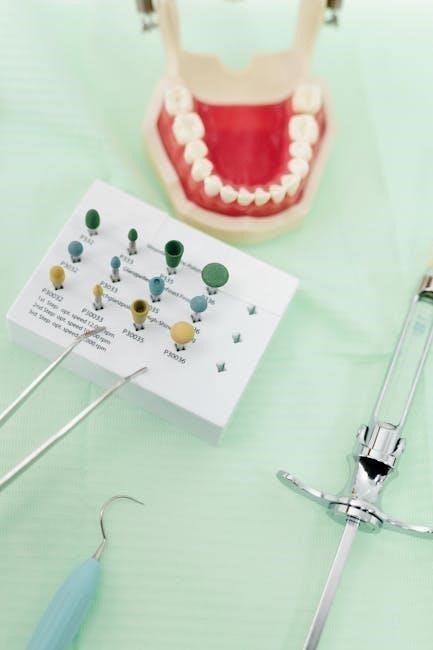
Pediatric and Geriatric Dentistry
Pediatric dentistry focuses on children’s oral health, addressing primary teeth and developmental issues. Geriatric dentistry manages elderly dental care, including dentures and age-related conditions like dry mouth and gum recession.
11.1 Pediatric Terms
Pediatric dental terminology focuses on children’s oral health, including terms like primary teeth, mixed dentition, and fluoride treatments. Key terms include “pedodontics” (study of children’s dental health) and “sealants” (protective coatings for molars). Pediatric terms emphasize preventive care, such as early childhood caries and orthodontic assessments, ensuring clear communication among dental professionals for effective treatment of young patients.
11.2 Geriatric Terms
Geriatric dental terminology addresses oral health issues in elderly patients, including terms like “edentulous” (toothless) and “periodontitis.” Key terms involve dentures, dental wear, and age-related conditions. Geriatric terms also cover prosthetics, implants, and systemic health impacts on oral care, ensuring comprehensive communication for treating older adults’ unique dental needs and maintaining their oral function and aesthetics.
Dental terminology PDFs provide essential knowledge, enhancing communication and care. Understanding these terms is vital for students and professionals, ensuring accurate diagnoses and effective treatments in dentistry.
12.1 Summary
Dental terminology serves as the foundation for clear communication in dentistry, covering essential concepts like tooth surfaces, anatomical structures, and procedural terms. PDF resources provide organized learning tools, helping students and professionals master these terms. Understanding dental terminology is crucial for accurate diagnoses, effective treatments, and maintaining high standards of patient care in the ever-evolving field of dentistry.
12.2 Future of Dental Terminology
The future of dental terminology lies in its evolution with advancing technologies and treatments. As dentistry embraces innovations like 3D printing and AI, new terms will emerge to describe these advancements. Standardization of terminology will remain crucial for global communication. Digital resources, including PDF guides, will continue to play a key role in disseminating updated information, ensuring accessibility and understanding for both professionals and students.
